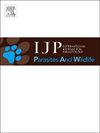Is Ornithoctona laticornis (Diptera: Hippoboscidae) expanding its range from Africa into Europe? First confirmed record in Romania
IF 2
3区 医学
Q3 ECOLOGY
International Journal for Parasitology-Parasites and Wildlife
Pub Date : 2025-05-27
DOI:10.1016/j.ijppaw.2025.101089
引用次数: 0
Abstract
The bird louse fly Ornithoctona laticornis (Diptera: Hippoboscidae), previously known only from Africa, has recently been recorded in Europe (Hungary) for the first time, raising questions about its potential range expansion. In this study, we document the first record of O. laticornis from the Syrian Woodpecker (Dendrocopos syriacus) in 2022 and another from the Great Spotted Woodpecker (Dendrocopos major) in 2023, both in Romania. Morphological description and molecular analysis of the mitochondrial cytochrome c oxidase subunit 1 gene confirmed the species identity. The main morphological criteria for the identification of O. laticornis were used in the updated key for the European genera of Hippoboscidae. The recurring presence of O. laticornis in resident European birds suggests either overwintering survival or multiple introductions via migratory hosts. Given the ability of hippoboscid flies to act as vectors of pathogens, this discovery underscores the importance of continued surveillance of avian ectoparasites in Europe. Further studies are needed to assess the distribution of the species, its genetic diversity, host range, and its potential role as a vector.

黑翅鸟(双翅目:海马科)是否将其活动范围从非洲扩展到欧洲?罗马尼亚首例确诊病例
鸟虱蝇Ornithoctona laticornis(双翅目:海马科),以前只在非洲发现,最近在欧洲(匈牙利)首次被记录到,这引起了对其潜在范围扩大的质疑。在这项研究中,我们记录了2022年来自叙利亚啄木鸟(Dendrocopos syriacus)的第一次记录,以及2023年来自大斑点啄木鸟(Dendrocopos major)的另一次记录,两者都在罗马尼亚。线粒体细胞色素c氧化酶亚基1基因的形态描述和分子分析证实了该物种的身份。在更新的马尾科欧洲属分类表中,采用了主要的形态学鉴定标准。在欧洲候鸟中反复出现的O. laticornis表明要么是越冬生存,要么是通过迁徙宿主多次引入。鉴于马尾蝇作为病原体载体的能力,这一发现强调了在欧洲继续监测禽外寄生虫的重要性。需要进一步的研究来评估该物种的分布、遗传多样性、寄主范围及其作为媒介的潜在作用。
本文章由计算机程序翻译,如有差异,请以英文原文为准。
求助全文
约1分钟内获得全文
求助全文
来源期刊

International Journal for Parasitology-Parasites and Wildlife
Medicine-Infectious Diseases
CiteScore
3.80
自引率
5.60%
发文量
113
审稿时长
45 days
期刊介绍:
The International Journal for Parasitology: Parasites and Wildlife (IJP-PAW) publishes the results of original research on parasites of all wildlife, invertebrate and vertebrate. This includes free-ranging, wild populations, as well as captive wildlife, semi-domesticated species (e.g. reindeer) and farmed populations of recently domesticated or wild-captured species (e.g. cultured fishes). Articles on all aspects of wildlife parasitology are welcomed including taxonomy, biodiversity and distribution, ecology and epidemiology, population biology and host-parasite relationships. The impact of parasites on the health and conservation of wildlife is seen as an important area covered by the journal especially the potential role of environmental factors, for example climate. Also important to the journal is ''one health'' and the nature of interactions between wildlife, people and domestic animals, including disease emergence and zoonoses.
 求助内容:
求助内容: 应助结果提醒方式:
应助结果提醒方式:


